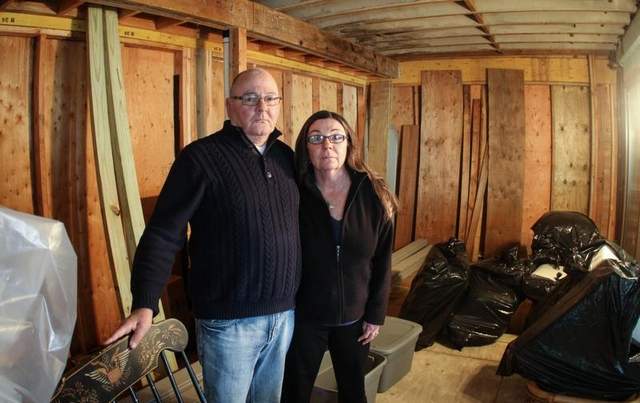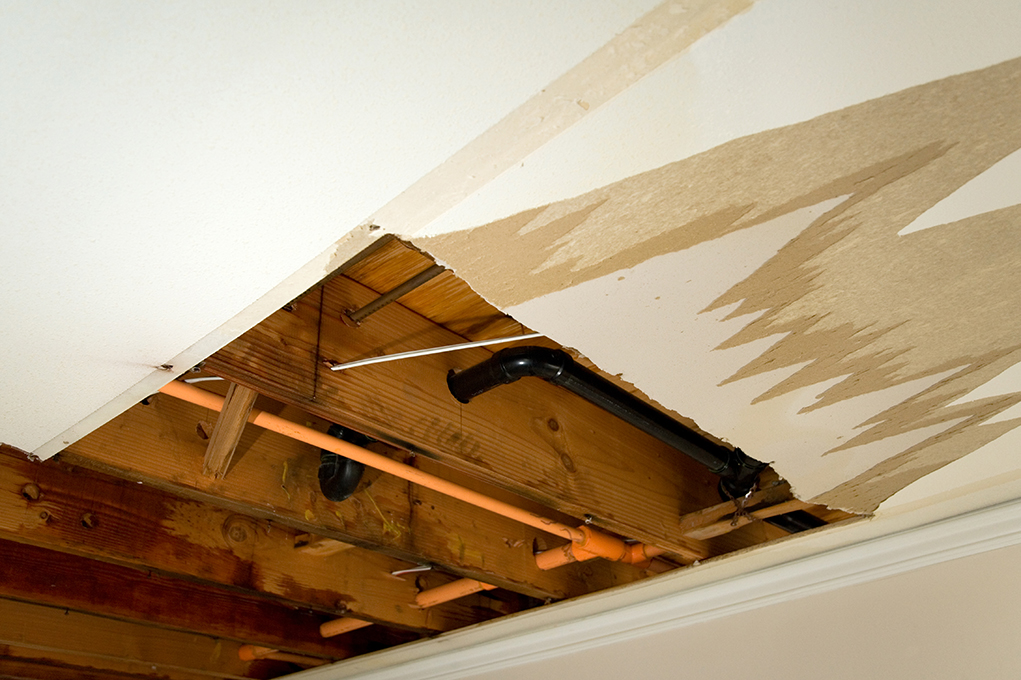

Point Pleasant Beach — The beachfront home of Vincent and Carla Vitale was severely damaged in superstorm Sandy, yet they are still battling with their insurance companies what they feel is a fair and proper reimbursement. / Tom Spader/Asbury Park Press
Sandy victims, frustrated by pennies on the dollar offers, sue en masse
Source – Asbury Park Press, March 14, 2014
Since they bought their oceanfront home in Point Pleasant Beach 12 years ago, Carla and Vincent Vitale have spent almost $100,000 on insurance premiums. So when flood waters from superstorm Sandy damaged the heating and electric system, they weren’t worried.
They could afford to rebuild, they thought. They were insured.
Sixteen months later, they have received no money from their flood insurance and an offer of $4,700 from their homeowners policy, hardly enough to repair what they estimate is almost $300,000 in damage. It amounts to less than 2 cents on the dollar.
“We would have been better off without insurance,” said Carla Vitale, 63.
New Jersey policyholders trying to rebuild from Sandy have received on average of less than $50,000 from their flood insurance policies, far less than policyholders in New York received after the same storm and policyholders in the Gulf Coast received after Hurricane Katrina struck in 2005, according to data from the Federal Emergency Management Agency.
It has touched off hundreds of lawsuits in federal court from homeowners who say they have been shortchanged.
The stingy reimbursement shouldn’t be a surprise after FEMA came under fire for overpaying the private insurance companies that administer the agency’s flood insurance program after Katrina. But it comes as homeowners are facing huge increases in premiums to help return the program to solvency. And their current experience has them — along with consumer advocates — wondering if they would be better off putting money in a bank account each month instead of paying premiums for an insurance policy that won’t pay off.
“Fifty thousand dollars is not going to rebuild any house today,” said Amy Bach, executive director of United Policyholders, a consumer advocacy group based in San Francisco that focuses on insurance issues. “It does raise a very serious question about the current integrity of people’s insurance safety net.”
A $10,000 check
Homeowners have two types of insurance to cover property damage: policies they buy from private insurers to cover damage caused by wind, rain, trees and fire, and insurance they buy from the federal government to cover damage caused by flood. The flood policies are often sold and managed by private companies, but they are financed by the federal government.
Flood policies cost on average $650 a year, according to FEMA. Homeowners can receive up to $250,000 to repair building damage and up to $100,000 to replace contents.
The Vitales shouldn’t have had a problem getting reimbursed. They had a $250,000 flood policy and a homeowners policy, Carla Vitale said.
They rode out the Oct. 29, 2012 storm at the Hilton Garden Inn in Lakewood and returned home to find moderate damage. There was 29-inches of water in the crawlspace — enough to damage the heating and electric system — and a foot of water in the garage. The storm meantime uprooted their flagpole and drove it through the plate glass windows of their sun porch. The water-damaged floors needed to be redone in the home once valued at $2.3 million.
A FEMA claims adjuster arrived a week later and said the damage to the interior of the house was not caused by flood waters. And an engineer hired by the Vitales agreed.
They turned to their homeowners policy. The first adjuster from Atlantic States, the Vitales’ Marietta, Pa.-based homeowners insurance company, gave the couple an estimate of $60,000 in damage. But the couple never received that money. Instead, they were notified that a new adjuster had been assigned to their case. Atlantic States could not be reached for comment.
The new adjuster arrived more than three months later. “He turned around and says our claim is worth $10,000,” Carla Vitale said. The insurance company eventually sent the couple a $10,000 check.
The insurance company wasn’t done. A third adjuster came to the house several weeks later. “He said our claim was worth $4,700,” Carla Vitale said. “This is after they sent a check for $10,000. Now I’m thinking, do we owe them money?” Vitale said the couple must now go back to FEMA to try to get more money through a flood insurance claim.
$3.5 billion paid out
The idea of government-backed insurance might sound unusual for a country that prides itself on private enterprise. But private insurers stopped covering flood damage in 1929, deciding it wasn’t profitable.
It wasn’t until 1968 that Congress created the National Flood Insurance Program to provide flood insurance and manage flood plains.
Sandy damaged 325,000 housing units — a little more than 9 percent of the state’s housing supply — totaling $5.9 billion, according to a study by Stephanie Hoopes Halpin, a professor at Rutgers University, Newark.
In New Jersey, FEMA said it received 74,052 claims and paid out about $3.5 billion, an average of $47,264. In New York, the agency said it received about 57,000 claims and paid out about through $3.7 billion for an average of $64,912.
Both states pale when compared with Hurricane Katrina, the August 2005 storm that devastated the Gulf Coast. There, FEMA said it received 167,712 claims and paid out $16.3 billion for an average of $97,053.
“We were getting 70 cents to 80 cents on the dollar with Katrina,” said Leslie Knox, a public insurance adjuster with Andrew K. Knox and Co. in Toms River. “We’re down to 40 cents on the dollar.”
Vincent Simonelli, president of Dream Homes Ltd., a home builder based in Lacey, agreed. “Homeowners are getting by my calculations, 30 to 40 cents on a dollar of loss,” he said. “That’s what the real numbers seem to be.”
Why the disparity? A FEMA spokesman said New York had a greater storm surge, which caused a greater loss. And construction costs are higher in the Empire State. Figures from RSMeans Construction Data, which itemizes material and labor prices by geographic location, appear to bear that out. A dishwasher with at least four cycles costs on average $751 in Staten Island and $572 in Point Pleasant.
Compared with Katrina, though, New Jersey residents don’t come close. Why not?
Katrina took out more expensive buildings. The Gulf Coast hurricane was the costliest in U.S. history, hitting the coast as a Category 3 hurricane with sustained winds topping 120 mph. It caused both flooding 20 feet deep and wind damage associated with a moderate tornado. And it took aim on expensive, commercial property. In Biloxi, Miss., for example, casinos were demolished; in Atlantic City, casinos largely escaped Sandy’s wrath.
“In New Jersey, there are a lot of very small, second homes that are part of the inventory (damaged by Sandy),” said Martin L. Mayo, a Houston attorney who represents residents whose homes were damaged by Sandy and received reimbursement on their flood claims that they contend was inadequate. “Those homes replacement cost value is usually less than $150,000 or even $125,000.”
Private companies that write flood policies for FEMA have a new incentive to be stingy.
FEMA hires private insurance companies to sell and administer flood policies and adjust claims after floods. Although homeowners write checks to a private insurance company, the program is financed by FEMA.
The adjusters sent to flood-damaged homes are paid by the size of the loss. The bigger the loss, the bigger the pay day. It rewards them based on the amount of work they do. But it also gives them an incentive to be generous.
Government reports after Katrina and other hurricanes found that FEMA never tracked what it cost private companies to administer the program. The General Accounting Office in 2009 found FEMA paid six private insurance companies $327.1 million more than their expenses over the course of three years.
Since then, FEMA has tightened its oversight with regular audits and a monitoring system, subsequent GAO reports found. And insurers who are found by FEMA to have overpaid need to reimburse the agency out of their own pockets, Mayo said.
“They’ve become conservative,” Mayo said of the private insurers. “They would rather underpay the claim than overpay the claim and pay it back later.”
“The claims adjusters were much more generous paying out flood claims than they are now,” said Bach, from United Policyholders. “Everybody I talked to then maxed out at $250,000. I don’t know anyone who maxed out after Sandy.”
Industry officials said claims adjusters have been more cautious in recent disasters, taking longer to complete their work and ensuring they don’t overpay.
“In Sandy they made sure they followed (the rules) specifically,” said Don Griffin, a vice president for the Property Casualty Insurers Association of America, a Chicago-based trade group whose members include most of the companies providing flood insurance. “I don’t know they paid out less than was allowed or were more conservative that way. I think what happened is it took them longer to settle those claims because they were being more careful not to make mistakes.”
It has left some New Jersey homeowners feeling short-changed. More than 600 lawsuits have been filed by New Jersey policyholders against their flood insurer, claiming they weren’t reimbursed what they were owed.
Taxpayer savings?
One group, however, stands to benefit from the conservative claims adjusting: taxpayers. The NFIP has been marked by shortfalls. Between 1970 and 1980, for example, the program borrowed $854 million from taxpayers to make up for premiums that were too low, the American Academy of Actuaries noted.
By today’s standards, that seems modest. The program by the time Sandy hit had just $4 billion in cash on hand, forcing Congress to increase the amount it could borrow from the U.S. Treasury — from $20.7 billion to $30.4 billion, according to a Congressional Budget Office report.
The program currently is $24 billion in debt, said Steve Ellis, vice president of Taxpayers for Common Sense, a Washington, D.C., research group. Congress planned to let the rates rise 25 percent, but sent a bill Thursday to President Barack Obama that would delay the boost following homeowner outrage.
For now, New Jerseyans trying to rebuild from Sandy face a gap. Sixteen months after the storm, the broken plate glass is boarded up and the sun porch remains in disarray at the Vitales. They spent $80,000 of their own money to replace heating and electrical system and make their home liveable.
Carla Vitale’s long-dormant Lupus, a disease of the immune system, has flared, a development the Vitales blame on stress related to fighting over their insurance settlement. And Vincent Vitale, a retired Wall Street trader, is emotionally drained. The past 12 years, they have paid about $5,500 annually for flood insurance and $2,200 for homeowners insurance, amounting to $96,000.
They are working through their options. They are considering hiring a lawyer. And they are trying to sell their house. It was on the market before Sandy, listed at $2.5 million. Now it is listed at $1.4 million — as is.
“I used to love the beach and the house,” Vincent Vitale said. “Now it’s depressing.”




